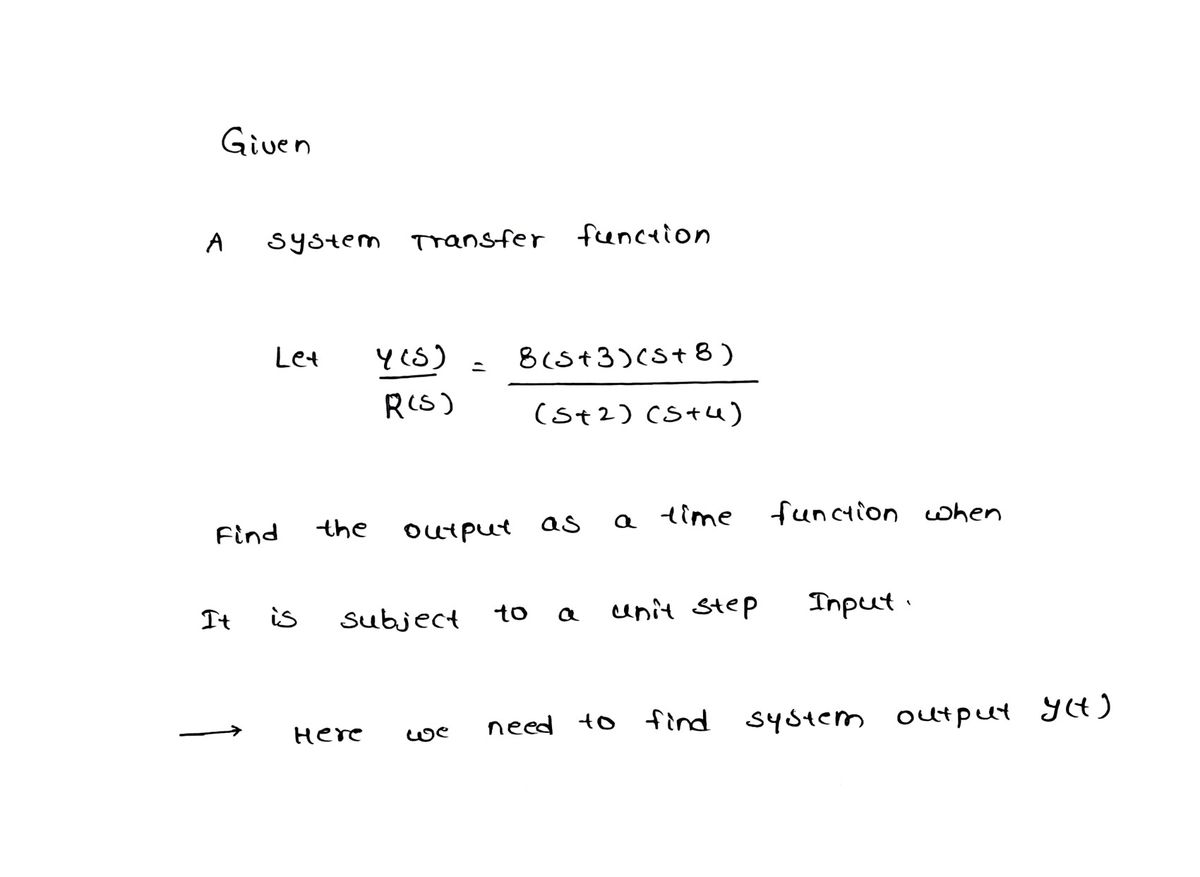19. A system has a transfer function of: 8(s+3)(s+8) (s + 2)(s+4) What will be the output as a time function when it is subject to a unit step input? Hint: use partial fractions.
19. A system has a transfer function of: 8(s+3)(s+8) (s + 2)(s+4) What will be the output as a time function when it is subject to a unit step input? Hint: use partial fractions.
Introductory Circuit Analysis (13th Edition)
13th Edition
ISBN:9780133923605
Author:Robert L. Boylestad
Publisher:Robert L. Boylestad
Chapter1: Introduction
Section: Chapter Questions
Problem 1P: Visit your local library (at school or home) and describe the extent to which it provides literature...
Related questions
Question
Number 19. Please find only the final value of the output for a unit step input using the tibia value theorem.

Transcribed Image Text:A
68 Page view
oyunuan nigo apar or a venge ampu
True to the input to and function.
system has an input of a voltage of a ramp voltage which increases at 5 V/s. What is the input as an
function?
Read aloud
A system gives an output of 1/(s+5) V(s). What is the output as a function of time?
5. A system has a transfer function of 5/(s+3). What will be its output as a function of time when subject
a unit step input of 1 V and (b) a unit impulse input of 1 V?
6. A system has a transfer function of 2/(s + 1). What will be its output as a function of time when subject te
a step input of 3 V and (b) an impulse input of 3 V?
17. A system has a transfer function of 1/(s+2). What will be its output as a function of time when subject to
a step input of 4 V and (b) a ramp input unit impulse of 1 V/s?
18. Use partial fractions to simplify the following expressions:
(a)
S-6
(s-1(s-2)'
19. A system has a transfer function of:
(b)
8(s + 3)(s+8)
(s + 2)(s + 4)
What will be the output as a time function when it is subject to a unit step input? Hint: use partial
fractions.
20: A system has a transfer function of:
G(s) =
s+5
(c)
s2 + 3s +2'
What will be the output from the system when it is subject to a unit impulse input? Hint: use partial
fractions.
(b)
21. What will be the state of damping of systems having the following transfer functions and subject to a unit
step input?
(a)
1
s²+2s +1'
22. The input x and output y of a system are described by:
8(s + 1)
(s+2)²
dy
dx
d'y
d1²
1
s²+7s+12'
+ 2y = x
2s 1
(s+1)²
+3
(c)
Determine how the output will vary with time when there is an input which starts at zero time and then
increases at the constant rate of 6 units/s. The initial output is zero.
23. The input x and output y of a system are described by:
dy
dx
+2y=x
initially the input and output are zero, what will be the output when there is a unit step input
ad outputy of a systein are described by:
1
s²+s+1
Expert Solution
Step 1

Trending now
This is a popular solution!
Step by step
Solved in 4 steps with 4 images

Knowledge Booster
Learn more about
Need a deep-dive on the concept behind this application? Look no further. Learn more about this topic, electrical-engineering and related others by exploring similar questions and additional content below.Recommended textbooks for you

Introductory Circuit Analysis (13th Edition)
Electrical Engineering
ISBN:
9780133923605
Author:
Robert L. Boylestad
Publisher:
PEARSON

Delmar's Standard Textbook Of Electricity
Electrical Engineering
ISBN:
9781337900348
Author:
Stephen L. Herman
Publisher:
Cengage Learning

Programmable Logic Controllers
Electrical Engineering
ISBN:
9780073373843
Author:
Frank D. Petruzella
Publisher:
McGraw-Hill Education

Introductory Circuit Analysis (13th Edition)
Electrical Engineering
ISBN:
9780133923605
Author:
Robert L. Boylestad
Publisher:
PEARSON

Delmar's Standard Textbook Of Electricity
Electrical Engineering
ISBN:
9781337900348
Author:
Stephen L. Herman
Publisher:
Cengage Learning

Programmable Logic Controllers
Electrical Engineering
ISBN:
9780073373843
Author:
Frank D. Petruzella
Publisher:
McGraw-Hill Education

Fundamentals of Electric Circuits
Electrical Engineering
ISBN:
9780078028229
Author:
Charles K Alexander, Matthew Sadiku
Publisher:
McGraw-Hill Education

Electric Circuits. (11th Edition)
Electrical Engineering
ISBN:
9780134746968
Author:
James W. Nilsson, Susan Riedel
Publisher:
PEARSON

Engineering Electromagnetics
Electrical Engineering
ISBN:
9780078028151
Author:
Hayt, William H. (william Hart), Jr, BUCK, John A.
Publisher:
Mcgraw-hill Education,